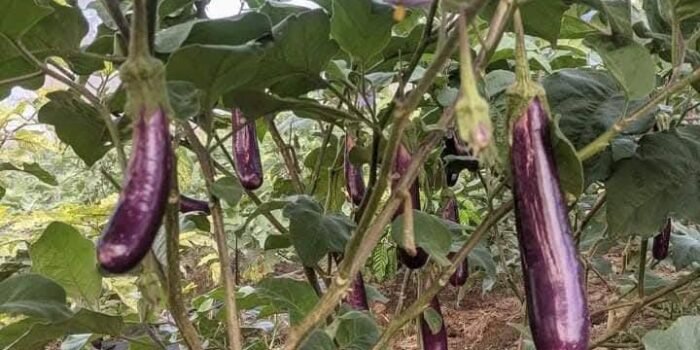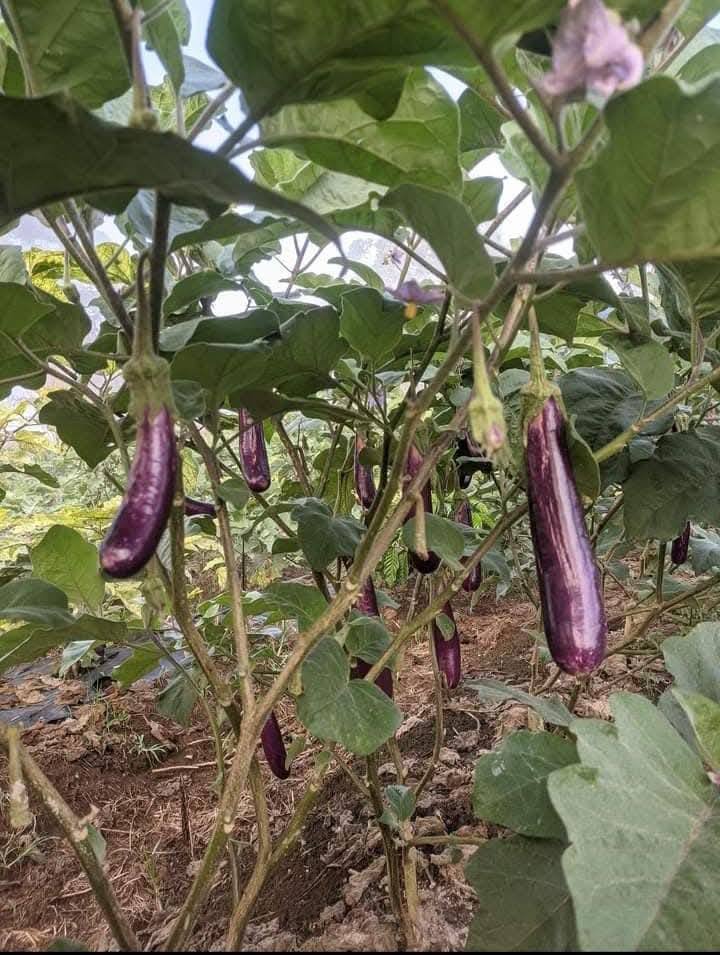Characteristics and description of eggplants King of the North F1, cultivation, care
Characteristics and description of the hybrid
The hybrid eggplant King of the North was bred specifically for the northern regions of Russia, which are part of the risky farming zone, but can also grow in the Central Belt. It grows and bears fruit equally successfully in greenhouses and in beds in the open ground. It is considered early maturing, from mass seed germination to the first harvest it takes no more than 95-100 days.

According to the description of the King of the North eggplants, these plants have:
medium-sized bushes in beds (55-70 cm) and tall in greenhouses (above 1 m);
stems of bright purple anthocyanin color;
the leaves are green, with veins of the same bright purple color as the stems;
numerous flowers of light purple color;
thornless stalks;
the fruits are long (25-30 cm) and thin (6-7 cm), elongated-cylindrical in shape, slightly curved;
They have glossy black-purple skin and tender white flesh that is not bitter and has an excellent taste.
The yield of the King of the North eggplant is 12-15 kg/m2 of plantings with an average weight of 1 fruit of 300-350 g. On each bush, an average of 10 fruits ripen.
This hybrid has the following distinctive characteristics:
phenomenal cold resistance;
early maturity;
tolerance to temperature fluctuations;
resistance to fungal diseases (powdery mildew, late blight, various rots);
absence of barren flowers;
long fruiting period;
stable and high yields.
eggplant seeds
Harvested eggplants are easy to transport and are suitable for preparing a variety of dishes that include this vegetable. They can be fried, stewed, baked, preserved, dried and frozen. If you put the fruits in a dark, cool place with 85-90% humidity, they can stay there for about 1 month.
Advantages and disadvantages
The King of the North hybrid has some advantages over other varieties of eggplant, which is why it has become a favorite among many Russian gardeners. They are especially attracted to it because:
its seeds have good germination;
the bushes grow quickly even under the most unfavorable conditions;
planted in beds in open ground, do not require tying;
you can harvest before frost;
The fruits are uniform, extremely tasty, and not bitter, so they do not need to be soaked before cooking.
Some people believe that the disadvantage of the King of the North is its long fruits, which, hanging on relatively low bushes, often touch the ground, get dirty and can rot. But this can be easily fixed by putting a thick material under them or mulching the bed. Some housewives do not like this shape of the fruits, who like to cut eggplants lengthwise. Another disadvantage of the King of the North, like any hybrid, is that you cannot use the seeds from its fruits for reproduction.
eggplant yield
Agricultural technology of cultivation and care
Eggplants King of the North F1 can be grown both in a greenhouse and on warm beds in the open ground. The plots should be well lit by the sun and protected from the effects of winds. Seedlings are planted in a permanent place; sowing seeds does not justify itself, since the plants do not have time to grow and give the entire harvest during the short summer season.
Forcing begins in early or mid-March. Fertile soil is prepared from a mixture of soil, humus, sand or sawdust, peat. The finished mixture is pre-disinfected, frozen, calcined or watered with potassium permanganate. Many gardeners also buy a substrate for vegetable crops in the store. Individual pots, cups, shallow boxes, and cassettes are used to grow eggplant seedlings.
Before sowing, eggplant seeds are warmed up and disinfected in fungicide solutions or potassium permanganate. If desired, they are soaked in growth stimulants or germinated. The prepared material is embedded in moist soil to a depth of 1.5-2 cm. The container is covered with film and left indoors at a temperature of 22-26 °C. It is optimal for rapid emergence of shoots. Thus, the first shoots usually appear on the 8-10th day, germinated seeds germinate on the 4-6th day.
agricultural technology of eggplants
After the shoots appear, the air temperature is reduced to 16-18 °C during the day and 13-15 °C at night. This allows the plants to develop a good root system and not stretch out in length. Then it is increased again. The plants are watered only with warm water. In the phase of 2 true leaves – they are pricked out. If eggplant seedlings are grown in individual containers, this procedure is skipped.
During cultivation, maintain daylight hours at 12 hours. In the morning and evening hours, plants are illuminated with lamps. Eggplants are fed several times with complex fertilizers, the first time 7-10 days after germination. Then, according to the instructions for the product used. The event is combined with irrigation. Before planting in open ground, seedlings are hardened.
The King of the North hybrid eggplant is transplanted to the beds when the soil warms up to at least 15 °C, approximately in May, early June. In a greenhouse, this is done 2-3 weeks earlier. The planting pattern used is: 40 cm between eggplants in a row and 60-70 cm between rows. The seedlings are lowered into the soil with a whole lump of earth, without damaging the roots; for this, the soil in the pots is well moistened.
Growing in greenhouses, King of the North eggplant bushes need to be tied to supports. This allows the plants to withstand a large harvest and not break. To prevent the tips of the fruits from rotting, mulching is used. When shaping the bushes, side shoots (stepchildren) are removed, as well as some of the lower leaves.
Further agricultural technology for growing the crop includes standard processes: watering, loosening the soil, fertilizing. Irrigation of plants is carried out in the evening hours and only with warm water. Young plants are watered once every 5-7 days, with the beginning of flowering and fruiting – 2 times a week. However, such a schedule is not the only correct one, weather conditions may be different. For watering adult eggplants, the liquid rate is increased.
agricultural technology of eggplants
Fertilizers are applied to the crop at least 3 times per season. If the soil was well fertilized with nutrients in the fall, this is quite enough for eggplants. The first time the plants are fed 2 weeks after planting the seedlings (mainly with nitrogen compounds), the second time – during the flowering period (with complex preparations), the third – during fruiting (phosphorus-potassium). Alternate the application of organic and mineral fertilizers.
Foliar fertilization of bushes gives good results, especially when there is a lack of macro- and microelements. On poor soils, eggplants are fertilized every 2 weeks throughout the growing season.






